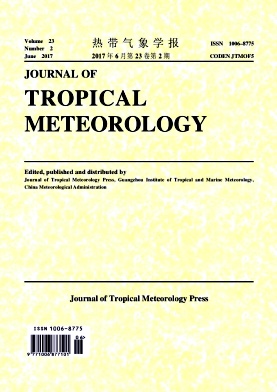THE DIRECT EFFECTS OF AEROSOLS AND DECADAL VARIATION OF GLOBAL SEA SURFACE TEMPERATURE ON THE EAST ASIAN SUMMER PRECIPITATION IN CAM3.0
doi: 10.16555/j.1006-8775.2017.02.010
- Rev Recd Date: 2017-04-06
Abstract: Using the CAM3.0 model, we investigated the respective effects of aerosol concentration increasing and decadal variation of global sea surface temperature (SST) around year 1976/77 on the East Asian precipitation in boreal summer. By doubling the concentration of the sulfate aerosol and black carbon aerosol separately and synchronously in East Asia (100-150 °E, 20-50 °N), the climate effects of these aerosols are specifically investigated. The results show that both the decadal SST changing and aerosol concentration increasing could lead to rainfall decreasing in the center of East Asia, but increasing in the regions along southeast coast areas of China. However, the different patterns of rainfall over ocean and lower wind field over Asian continent between aerosol experiments and SST experiments in CAM3.0 indicate the presence of different mechanisms. In the increased aerosol concentration experiments, scattering effect is the main climate effect for both sulfate and black carbon aerosols in the Eastern Asian summer. Especially in the increased sulfate aerosol concentration experiment, the climate scattering effect of aerosol leads to the most significant temperature decreasing, sinking convection anomalies and decreased rainfall in the troposphere over the central part of East Asia. However, in an increased black carbon aerosol concentration experiment, weakened sinking convection anomalies exist at the southerly position. This weakened sinking and its compensating rising convection anomalies in the south lead to the heavy rainfall over southeast coast areas of China. When concentrations of both sulfate and black carbon aerosols increase synchronously, the anomalous rainfall distribution is somewhat like that in the increased black carbon concentration aerosol experiment but with less intensity.
| Citation: | LIU Chao, HU Hai-bo, ZHANG Yuan, et al. THE DIRECT EFFECTS OF AEROSOLS AND DECADAL VARIATION OF GLOBAL SEA SURFACE TEMPERATURE ON THE EAST ASIAN SUMMER PRECIPITATION IN CAM3.0 [J]. Journal of Tropical Meteorology, 2017, 23(2): 217-228, https://doi.org/10.16555/j.1006-8775.2017.02.010 |

















 粤公网安备 4401069904700002号
粤公网安备 4401069904700002号
 DownLoad:
DownLoad: